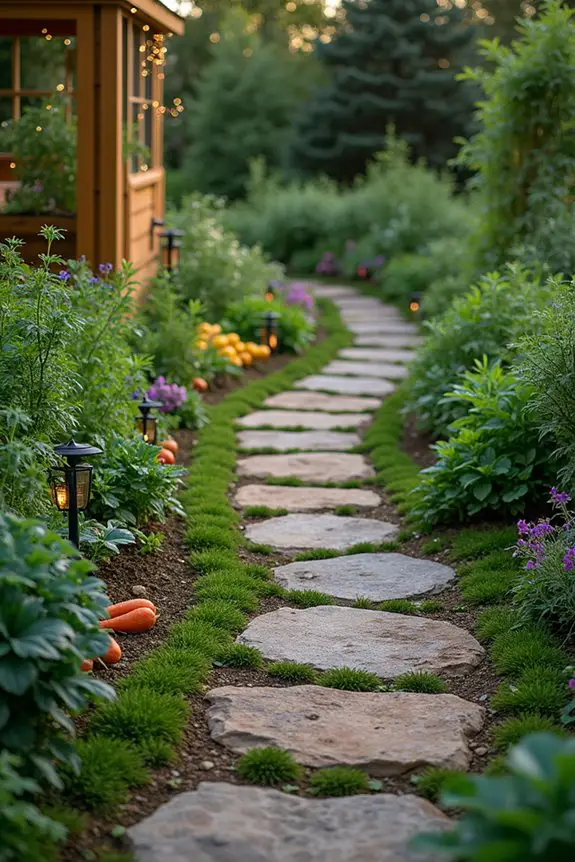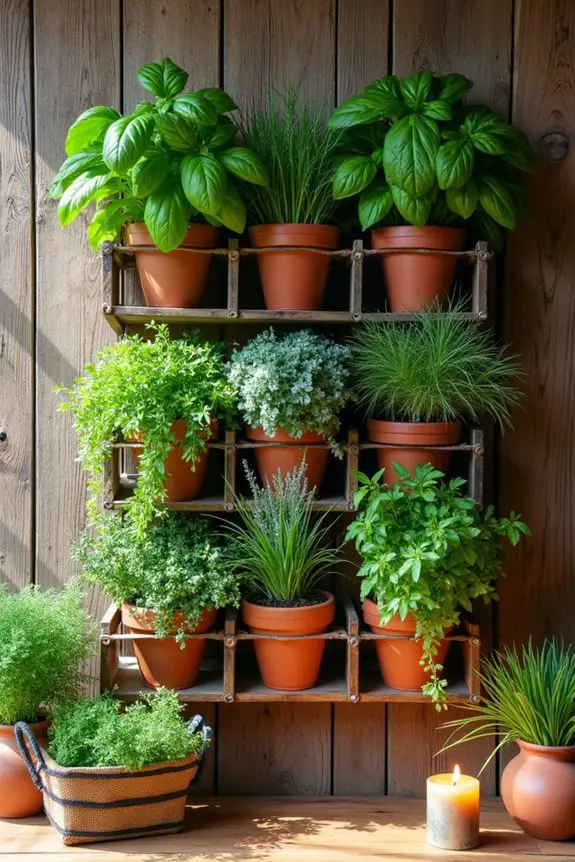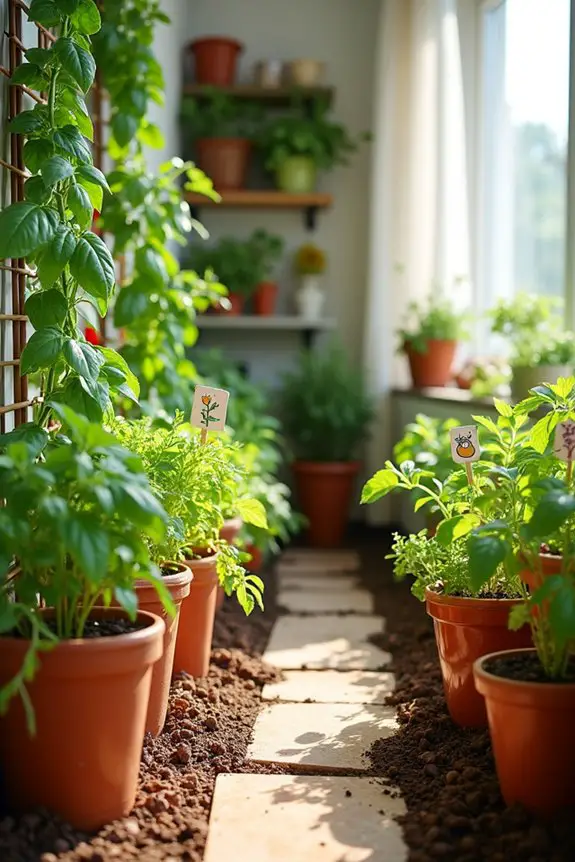Gardening can be a delightful little adventure, a way to create your own food oasis right at home. If you’ve ever thought about sprucing up your vegetable patch, you’re in for a treat. Imagine a vibrant herb spiral or a space-saving vertical garden—sounds tempting, doesn’t it? You won’t believe the creativity you can bring to your garden. So, what innovative ideas are waiting for you to explore? Let’s dig in.
Unique Layout Ideas
If you’re looking to shake things up in your vegetable garden, unique layout ideas can really make a difference.
Imagine vertical garden structures that save space or colorful raised beds that put your veggies on display like they’re in a fashion show.
Plus, integrating edibles into your landscape or creating an herb spiral can transform your yard into a charming mini-farm—who knew gardening could be this fun?
1. Vertical Garden Structures
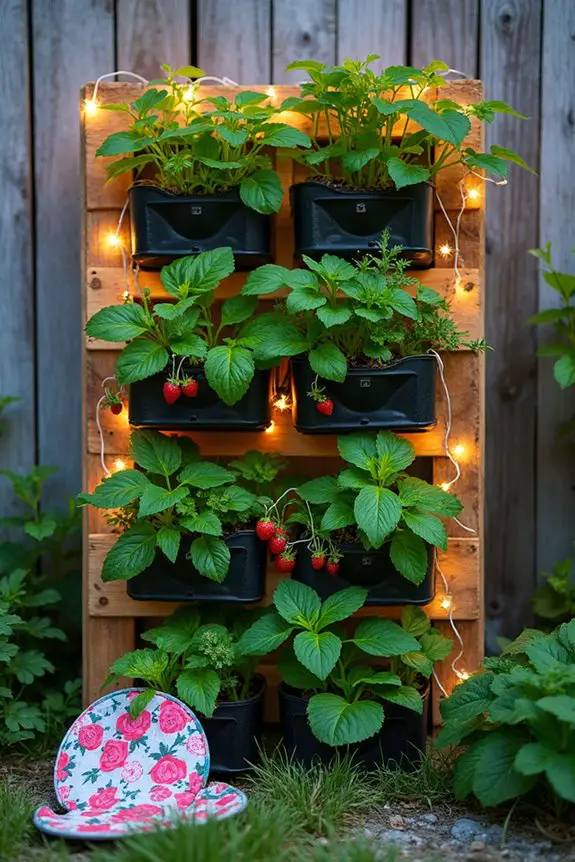
Vertical gardens aren’t just a space-saver; they add breathtaking beauty to your backyard. Imagine lush, vibrant plants climbing up your walls, creating a little green oasis right in your home. It’s a blend of functionality and style—perfect for those who want fresh veggies without taking up too much ground space. Using a foam kneeling pad can make planting and maintaining your vertical garden much more comfortable, allowing you to enjoy the process without the strain on your knees.
A great way to build a vertical garden is by using a pallet. Yep, those wooden pallets you see lying around can be goldmines! First, just sand it down a bit to avoid splinters—for your sake and the plants’.
Then, line the back with some landscape fabric to keep the soil from falling out. Lay it flat for a few days to avoid splattering dirt everywhere when you stand it up. Who knew gardening could be so messy, right?
Now, let’s talk plants. Opt for herbs, leafy greens, or even strawberries—they’ll love climbing their way to the sun. Just fill the pallet with soil, pressing it in so it doesn’t tumble out later.
Then tuck in your plants, and voilà! You’ve created a handy vertical garden that not only saves space but looks stunning too. Adding a soaker hose splitter can help distribute water efficiently, ensuring all your plants get the hydration they need without overwhelming them.
If you’re feeling adventurous, try adding a little fairy light garland around your vertical garden. How charming would that be? Imagine watering your plants in the soft glow of lights at twilight—pure magic.
And let’s be honest, if you accidentally drown a few herbs (guilty as charged), at least the fairy lights will still make your garden look good.
The best part of vertical gardens? They’re as forgiving as they’re beautiful.
2. Colorful Raised Bed Arrangements
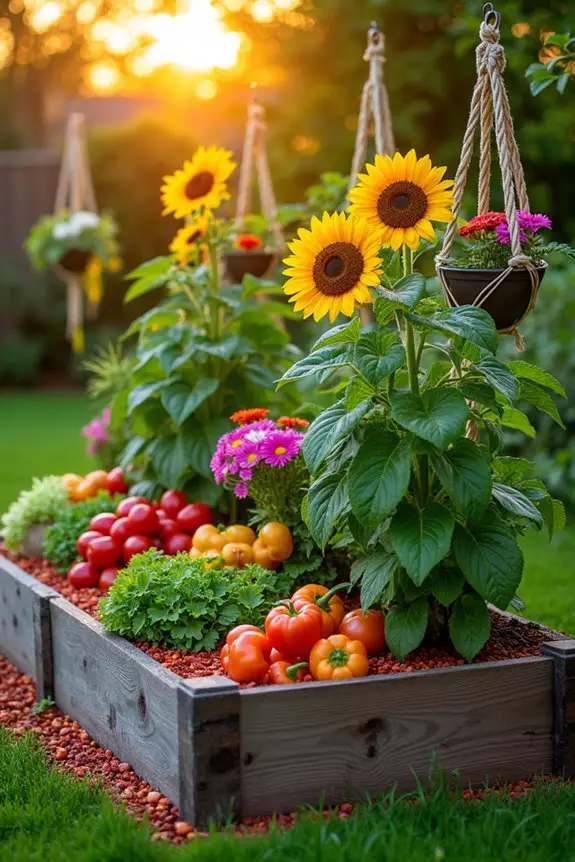
Raised beds are like the rock stars of the gardening world. Not only do they make tending to your garden easier, but they also allow you to showcase a beautiful kaleidoscope of colors and textures. Imagine walking out to your garden and feeling like you’ve stepped into a painter’s palette, with vibrant greens, striking reds, and cheerful yellows all vying for your attention. It’s a feast for the eyes and the palate!
To create a stunning raised bed arrangement, think about layering your plants. Start with tall, show-stopping plants like sunflowers or tall tomatoes at the back. They’ll make the perfect backdrop. Then, mix in medium-height beauties such as peppers or zinnias in the middle, followed by low-growing herbs like basil and parsley at the front. Trust me, those fragrant herbs won’t only taste great in your pasta but will also add a splash of green to your setup.
Don’t forget to play with colors too. Pair purple eggplant with golden squash, or vibrant red radishes alongside crisp green lettuce. Think of it as styling your garden—each plant serving its role, just like in a good outfit. And for a little extra pizzazz, consider using colorful mulch or stones to complement your plants. It’s like the cherry on top of your garden sundae.
Oh, and a little tip from someone who may have accidentally planted a rainbow of veggies without much thought: keep track of what you put where. I once had a very confusing encounter when I thought my gorgeous purple flower was an eggplant. Spoiler alert: it wasn’t.
But hey, at least that mix-up gave me something to laugh about while pulling weeds! So, design your raised beds thoughtfully, and watch your outdoor space transform into a vibrant, edible artwork. Additionally, incorporating elements like macrame plant hangers can enhance the visual appeal of your garden setup.
3. Edible Landscape Integration
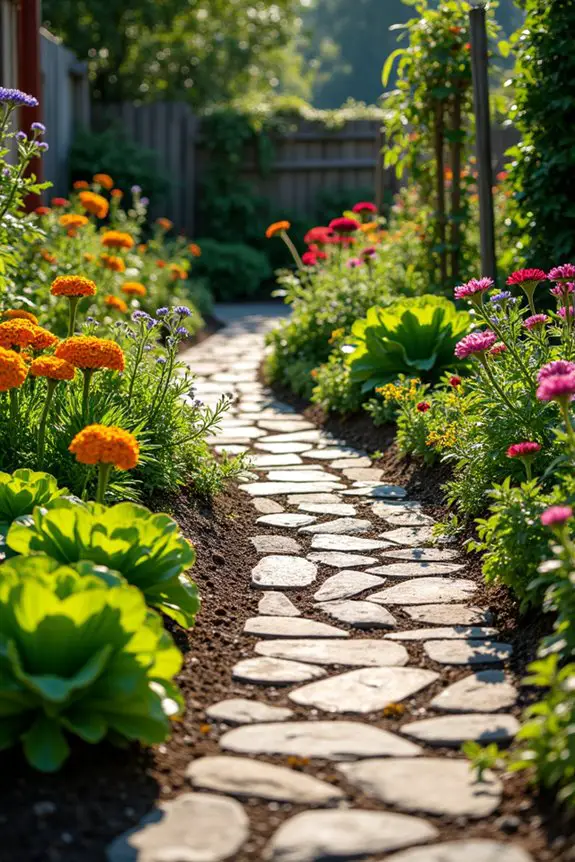
When you think about your yard, what if I told you it could be both beautiful and bountiful? That’s where edible landscape integration comes into play. Imagine strolling through your garden, nibbling on fresh strawberries while admiring the surrounding flowers. It’s like a scene from a dreamy movie—one where your garden is a feast for the eyes and the taste buds.
So, how do you create an edible landscape that doesn’t just look good but functions well, too? Start by mixing your flowers with veggies and fruit-bearing plants. For example, why not plant some vibrant marigolds between rows of lettuce? The marigolds brighten up your garden and help keep those pesky pests away. Talk about a two-for-one deal.
Just picture it: pop of color alongside crisp greens, all while encouraging a healthy ecosystem, like a garden party happening right in your backyard.
One unique layout idea is to create a winding pathway laced with edible plants. You could use low-growing herbs like oregano and thyme alongside beautiful, fragrant flowers like lavender. Trust me, nothing says “welcome” quite like the scent of fresh herbs greeting your guests. As they walk through, they might even pluck a sprig to toss in their salad later. It’s all about creating moments, right? Plus, consider incorporating an aeroponic growing system to maximize growth efficiency and yield in your edible landscape.
Oh, and here’s a gentle warning from someone who’s definitely overplanted before: be careful not to let your layout get too chaotic.
I once turned my front lawn into what looked like a confused jungle, with herbs and flowers vying for space as if they were in a race. Instead, keep things organized. Use borders, edgers, or even decorative rocks to clearly define your edible spaces. This way, you’ll create a harmonious balance between the beauty of flowers and the productivity of veggies.
4. Herb Spiral Configuration
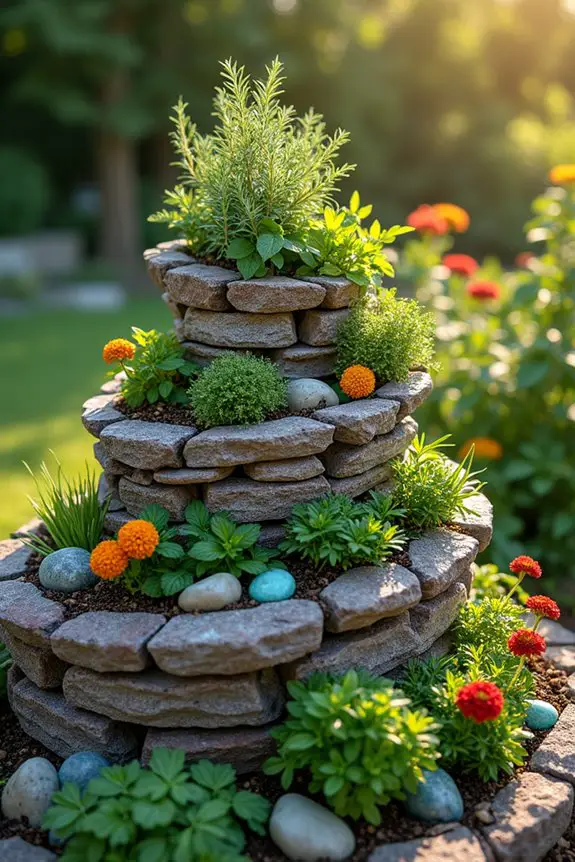
When it comes to creating a unique and functional garden layout, an herb spiral configuration deserves a spot on your design radar. Why, you ask? Well, not only does it maximize space, but it also creates a visually stunning centerpiece. It’s like a gardener’s dream—a swirling staircase of fragrant herbs and greens that captures the eye and enhances your cooking.
So, how does this magical spiral work? Imagine this: you start by digging a circular garden bed raised in the center, spiraling outward. The higher part of the spiral is warmer and drier, making it perfect for sun-loving herbs like rosemary and thyme. As you move down the spiral, the soil becomes cooler and moister, letting you plant mint and parsley. Now you have a variety of herbs happy in their specific micro-climates, plus you save some precious space. It’s a win-win.
Here’s a little tip from my own experience: use rocks or bricks to form the spiral walls. Not only do they keep the soil in place, but they also add some character to your garden. Using high-quality tools like ratchet pruners can help maintain your herbs effortlessly as they grow.
And if you’re worried about weeding, just remember that the spiral will naturally form layers, making it easier to access your plants without uprooting everything. Trust me, it’s less backbreaking than trying to navigate a sprawling patch of basil.
Styling is key, so add some colorful stones, or even plant flowers in between your herbs for that extra flair. I once decided to stick vibrant flowers between my herbs, thinking it would be a charming touch.
Well, let’s just say I ended up with a colorful chaos that made it hard to find my favorite basil. So be sure to have a plan before you decorate your spiral. It’s all about balance, right?
In short, an herb spiral isn’t just a way to grow your kitchen herbs; it’s a statement piece for your garden that’s functional and fun.
5. Companion Planting Schemes
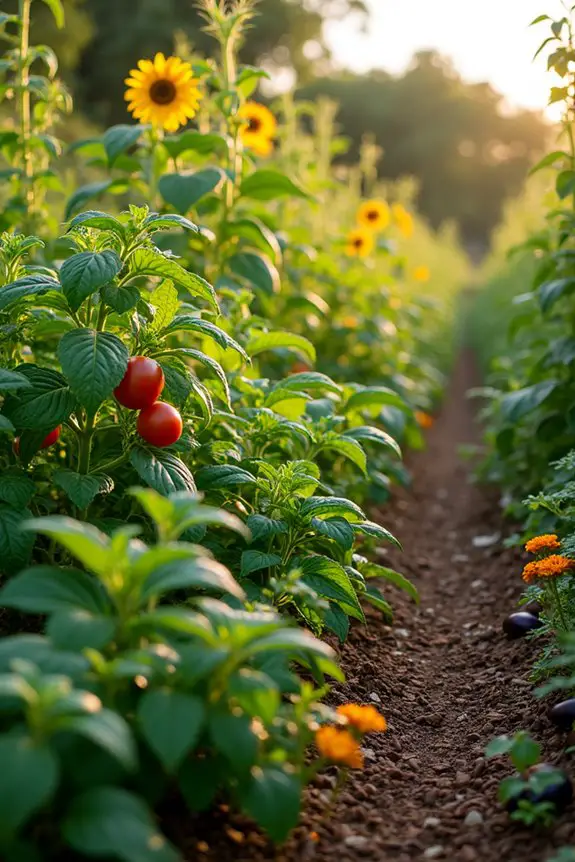
Companion planting schemes are like the ultimate party planners for your vegetable garden. Imagine hosting a gathering where all your plants get along beautifully, sharing nutrients, and keeping pests at bay. This layout not only maximizes your garden’s productivity but also creates a lively and colorful atmosphere—one that’s buzzing with the energy of life.
So, how do you start setting up this plant party? First, it’s essential to know which plants are best buddies (and which ones should stay on opposite sides of the garden). For example, tomatoes and basil are a match made in culinary heaven. Not only do they grow incredibly well together, but they enhance each other’s flavor. Just picture it: a tomato plant heavy with fruit, happily growing alongside aromatic basil, ready for that perfect caprese salad.
Next, try to create layers in your garden. Tall plants, like corn or sunflowers, can provide shade for shorter ones, while spreading plants, like squash, can cover the ground, reducing weeds. A tip from my many years of trial and error—space is your friend. Overcrowding can lead to a squabble among plants, so give them a little breathing room to thrive.
I once crammed every available plant into one small space, and let’s just say my garden turned into a botanical wrestling match. Lesson learned: less is more.
One more thing: consider color and texture. Mix leafy greens with vibrant flowers and colorful veggies. Think of it as your garden’s wardrobe change. Last summer, I threw in some vibrant calendula flowers amongst my beans. Sure, it was an experiment, but boy, did it make my garden pop.
Who knew that an edible flower would become the talk of my garden—beauty and function combined?
When you map out your companion planting schemes, remember that you’re not just planting. You’re creating harmony in nature’s little ecosystem right in your backyard. Plus, if you play your cards right, you’ll end up with healthier plants and, dare I say, tastier produce.
Who wouldn’t want that? So roll up your sleeves and let your plant pals do their magic—together, they’ll turn your veggie garden into a vibrant, bustling community.
6. Symmetrical Planting Patterns
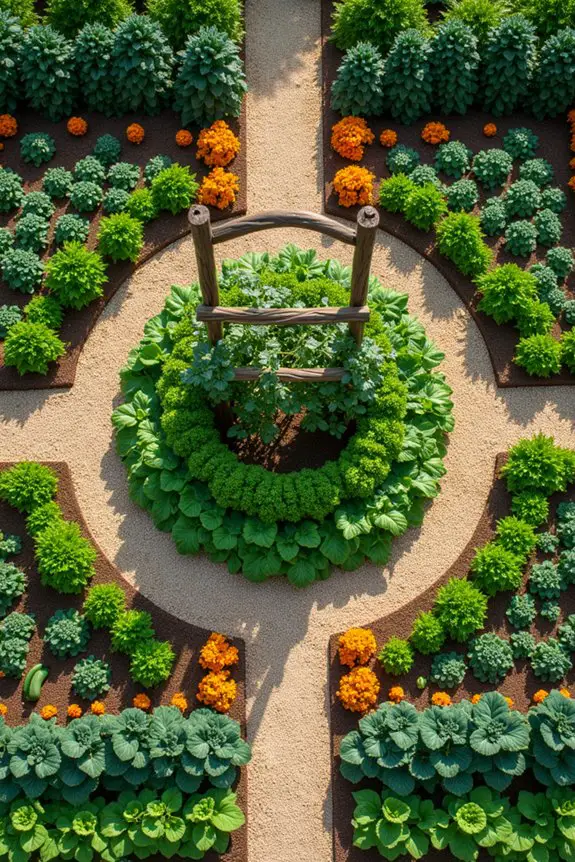
Symmetrical planting patterns add an artistic touch to your vegetable garden, making it look like a masterpiece straight out of a gardening magazine. Not only are they visually appealing, but they also help with organization, making it easier to navigate and maintain your garden space.
Envision your garden as a blank canvas—laying it out symmetrically can create a sense of balance and harmony that will leave you feeling proud every time you stroll by.
Start by selecting a focal point, like a stunning trellis or a charming birdbath. Everything else will revolve around this centerpiece. For instance, if you place your trellis at the center, you could create a circular planting bed around it. Imagine this: rows of leafy greens like kale and spinach marching gracefully around your trellis, perhaps bordered by colorful marigolds to keep the pests away. How inviting would that be?
One of my favorite techniques is the classic checkerboard pattern. It’s like playing tic-tac-toe but with your veggies. Alternating squares of different plants—say, cucumbers in one square and dwarf carrots in another—creates visual intrigue while giving each plant enough sunlight and space to flourish.
Plus, it makes weeding a breeze. Just remember to keep the plant heights in mind. You don’t want a tall plant casting shade on a shorter one without good reason, right?
And let’s not forget about paths. Adding symmetrical pathways not only enhances functionality but also makes the garden more accessible and aesthetically pleasing. Use stepping stones or gravel to define your paths, giving your feet a sturdy foundation while showcasing your beautiful vegetable arrangements.
The last thing you want is to step on your precious plants—I once did that and, oh boy, my zucchini plants weren’t impressed.
Finally, consider color coordination. Grouping plants based on leaves or flowers can create a stunning visual rhythm. Picture a patch of all green veggies bordered with bright orange nasturtiums—it’s like having a feast for the eyes!
7. Water Feature Integration
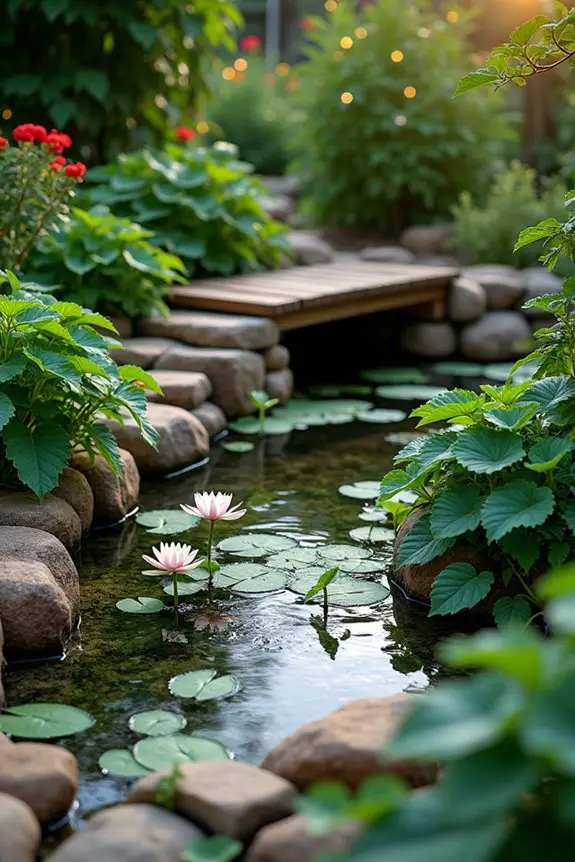
Integrating a water feature into your vegetable garden layout can transform the space into a serene retreat that’s both practical and picturesque. Not only does it provide a relaxing ambiance with the gentle sound of trickling water, but it can also offer your plants a much-needed source of hydration while attracting beneficial wildlife. Who wouldn’t want to hang out in a garden that feels like a mini oasis?
Consider placing a small pond or a bubbling fountain in a corner of your garden. Surround it with a mix of ornamental and edible plants to create a lush backdrop. I once added a tiny pond surrounded by mint and basil, and I can’t tell you how rejuvenating it was to stroll by and pluck a few leaves for my dinner. Plus, it was a hit with the dragonflies! They seem to think I built it just for them, flitting around like they own the place.
When designing your space, think about accessibility. You want your water feature to be both a focal point and functional. If you opt for a pond, you might include a small bridge or stepping stones to allow easy access for maintenance while also giving you that classic garden-path feel. It’s like being in a fairy tale—until I trip over the pathway and end up in the basil. Talk about a plant emergency.
And let’s not forget aesthetics. You can scatter stones or add aquatic plants like water lilies to enhance the look of your feature. These tiny details elevate the feel of your garden. I once tried to use colorful stones, thinking they’d add a pop of color, but ended up creating what looked like an unintentional abstract art piece. Let’s just say it was colorful, and I learned to stick with natural tones.
Lastly, consider lighting. Soft evening lights can illuminate your water feature beautifully, creating a magical glow that beckons you to unwind after a long day. Picture yourself sipping tea by the water, listening to the gentle sounds of nature. It’s peaceful, inspiring, and sometimes, I even forget my gardening woes.
Just don’t forget to keep it low-maintenance; you want to enjoy your garden, not spend all your time fussing over it.
Incorporating a water feature can bring life, style, and harmony to your vegetable garden—making it not just a place for growing food, but a true sanctuary.
8. Seasonal Plant Rotation Strategy
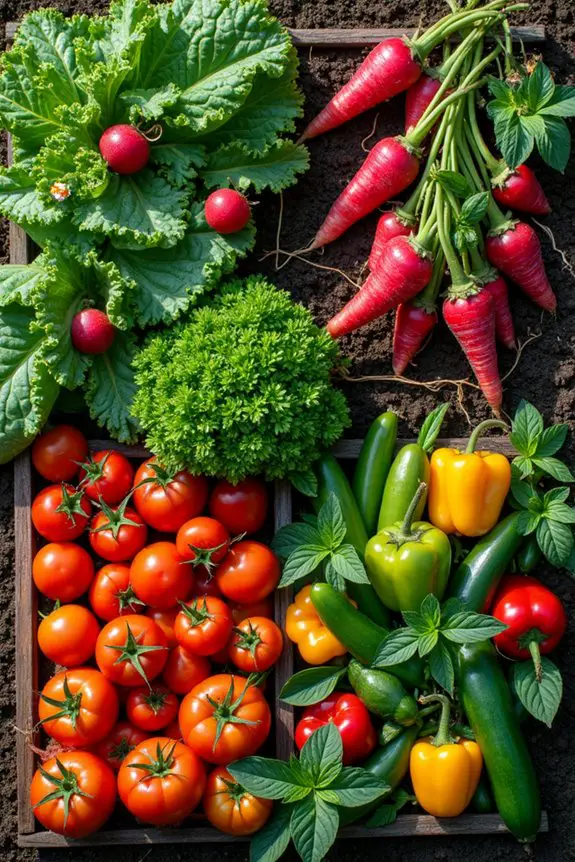
When it comes to a seasonal plant rotation strategy, a unique layout can really change the game. Not only does it keep your soil healthy and maximize your harvest, but it also brings a delightful evolution to your garden throughout the year. Imagine watching your garden transform as different vegetables come and go, creating a living tapestry of colors, shapes, and textures.
First off, consider a simple grid layout. Picture it: dividing your garden into equal sections—maybe a four-square system for clarity. In each square, you can plant different vegetables according to the season.
For spring, you might fill one with bright radishes and leafy greens while another could host blossoming peas. Then, come summer, you can swap them out for vibrant tomatoes and peppers. It’s like having a culinary rotation right in your backyard, and trust me, your taste buds will thank you.
Mixing in companion planting can add another layer of strategy. If you’ve got a square with tomatoes, why not pair them with basil? They thrive together, and the aroma in your garden will be heavenly. I once tried this strategy, and it felt like I was hosting a tiny dinner party right in my backyard—the tomatoes and basil were practically chatting about their flavor profiles.
Also, consider using vertical gardening techniques in your rotation. If space is tight, trellises can help vine crops like cucumbers and beans climb up while saving precious ground space.
I tried this in my garden, but it turned into a jungle of vines that could’ve hosted a reality show. Let’s just say I learned to bring a machete for my next harvest.
Another fun idea is to implement a themed rotation. For example, have a “Mexican fiesta” area where you grow cilantro, peppers, and tomatoes together one season, and maybe a “Mediterranean marvel” section with zucchini, oregano, and eggplant the next. It’s like a flavor adventure right at your fingertips!
Finally, don’t forget the importance of documenting your plant rotation. Grab a notebook or an app, and track what you planted where and when.
I didn’t do this once and ended up planting carrots in the same spot as last year, only to realize I’d some very confused bugs ready to feast on my new “crop.” Not my proudest gardening moment.
9. Seasonal Color Palettes
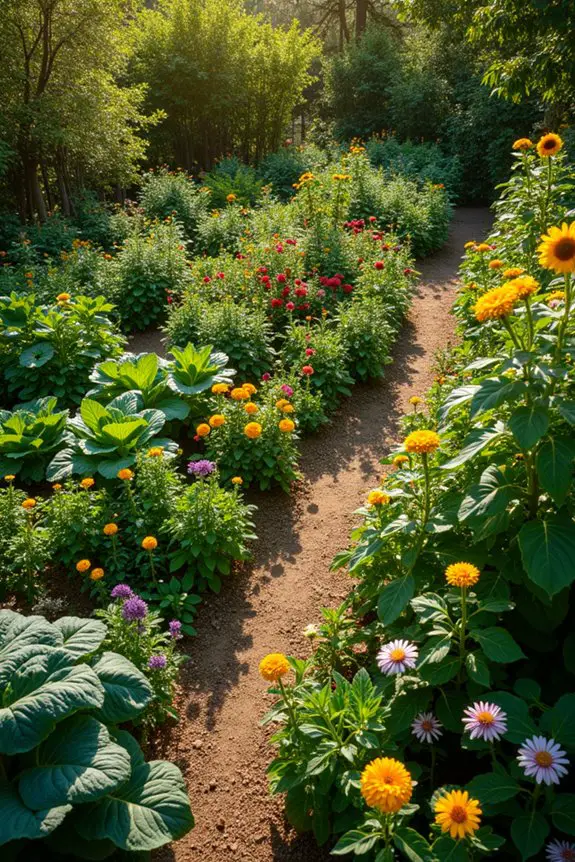
When it comes to designing your vegetable garden, layering seasonal color palettes can really enhance not just the functionality but also the vibe of your space. This idea works wonders because, let’s be honest, a vibrant garden isn’t just about the food—it’s about creating a joyful atmosphere that feels just as good as it looks.
Picture walking through your garden, surrounded by a rainbow of vegetables, flowers, and textures—it’s like stepping into your own countryside painting.
Start by mapping out the color themes for each season. In the spring, you can use bright greens and soft yellows with leafy greens and action-packed peas. Come summer, swap in rich reds and deep greens with those luscious tomatoes and peppers that practically scream “fresh salsa time.”
I once tried this approach, and let me tell you, my friends questioned whether I’d signed up for a gardening mastery class or just got lucky. Spoiler: it was a bit of both.
Grouping plants by color doesn’t only look lovely; it actually helps attract beneficial pollinators. Think about it: when bees and butterflies see clusters of colorful blooms, they buzz right in. Now, combine that with your veggies, and it’s like throwing a party for nature while you grow your dinner.
Remember, though—too much of one color can be a bit overwhelming. A small splash of a contrasting color, like glorious purple eggplants tucked amongst green zucchini, can provide a delightful surprise without being too much.
Consider using flowering herbs for a dash of elegance. You can plant bright yellow marigolds alongside your beans; not only will their vibrant hue brighten your garden, but they also act as natural pest repellents. Talk about a win-win.
I made the mistake of overlooking this once and ended up with a bug buffet—I think the critters were more excited than I was.
Above all, keep experimenting. It’s okay if your first attempt resembles a chaotic palette—everyone has to start somewhere. I certainly did.
My “paint strokes” were off the charts. I learned the hard way that some colors totally clash, like accidentally planting purple carrots next to yellow squashes. Let’s just say it was a lesson in aesthetics and the importance of careful planning.
Gardening, like cooking, is about finding the right balance, making adjustments, and just enjoying the process of creating something beautiful.
10. Garden Pathway Innovations
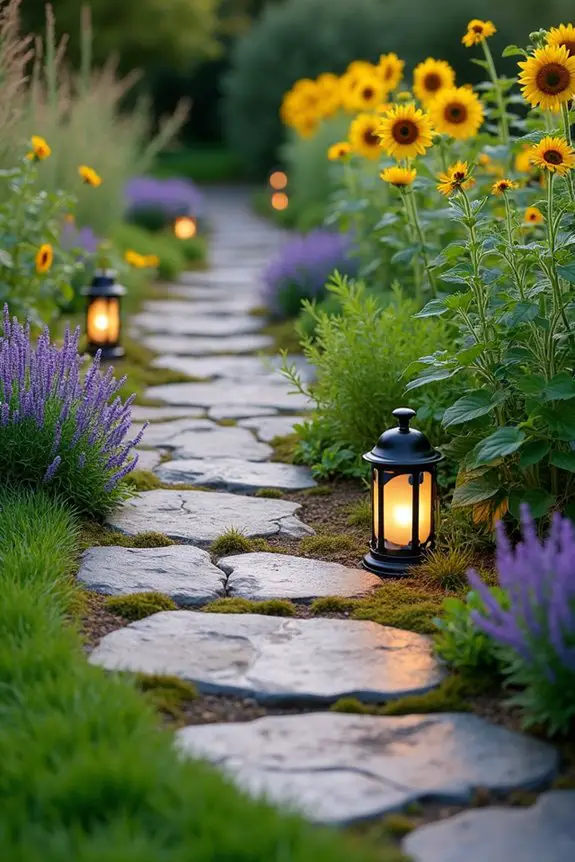
When it comes to vegetable gardens, garden pathways mightn’t be the first thing that springs to mind. But trust me, a well-designed pathway can transform your space from drab to fab. It doesn’t just help keep your shoes clean (though that’s definitely a bonus); it also adds rhythm and flow, making your garden feel organized and inviting.
Imagine strolling down a charming path surrounded by your flowering herbs and vibrant veggies, feeling like you’ve stepped into a secret sanctuary.
Now, let’s talk about some fun and unique layout ideas for your garden pathways. First up, consider going for a meandering path instead of a straight line. Curving pathways guide the eye and create an enchanting sense of mystery. Where does it lead? Is it a shortcut or a scenic route?
I once set out to create a simple straight path, only to end up with a twisty turny adventure that made my small garden feel like an enchanted maze. My kids thought they were in a real-life treasure hunt. Spoiler: there was no treasure, but they sure had fun.
Next, think about the materials you want to use for your path. You could go with classic gravel—it’s great for drainage and easy to apply. Or, if you’re feeling fancy, how about old bricks or flat stones? There’s something charming about a rustic stone path, and believe me, it makes you feel like you’ve traveled back in time to an old-fashioned garden.
Just be careful when setting those stones; I may or may not have misjudged the placement and ended up doing an unintended dance when I tripped.
For a touch of whimsy, try incorporating edible items along your pathway. Imagine walking past fragrant herbs like rosemary or mint. You get to enjoy the scent as you stroll while also grabbing a handful for dinner. It’s like a mini treasure hunt for your taste buds.
I once planted basil along my path, thinking it’d be a fantastic idea, but I ended up with a lot of mosquitoes attracted to that leafy goodness. Lesson learned: while herbs are fantastic, you might want to choose your companions wisely.
Lastly, add some lighting to your pathway. Little lanterns or solar lights can create a magical atmosphere in the evening. They not only guide your way but also turn your garden into a dreamy glow-up after sunset.
I’ll never forget the first night I turned on my pathway lights; it felt like walking through a fairy tale, though I did nearly step on a garden gnome hiding in the shadows—a comedic surprise for sure.
Garden Tool Organization Solutions
You’ve got your garden plans sorted, seedlings sprouting, and yet, somehow, your tools are scattered like confetti after a party.
It’s a bit chaotic, isn’t it? First off, try a simple pegboard in your shed; hang your most-used tools right where you can see them.
You’ll be amazed at how those vegetable garden ideas start sprouting into action when you don’t spend half an hour hunting for a trowel.
Or, get a rolling cart—perfect for moving your goodies around when you need to weed or harvest.
Trust me, a few labeled containers for smaller tools can save you from that “Where’s my secateurs?” moment.
No more digging through drawers; just quick access to what you need, when you need it.

